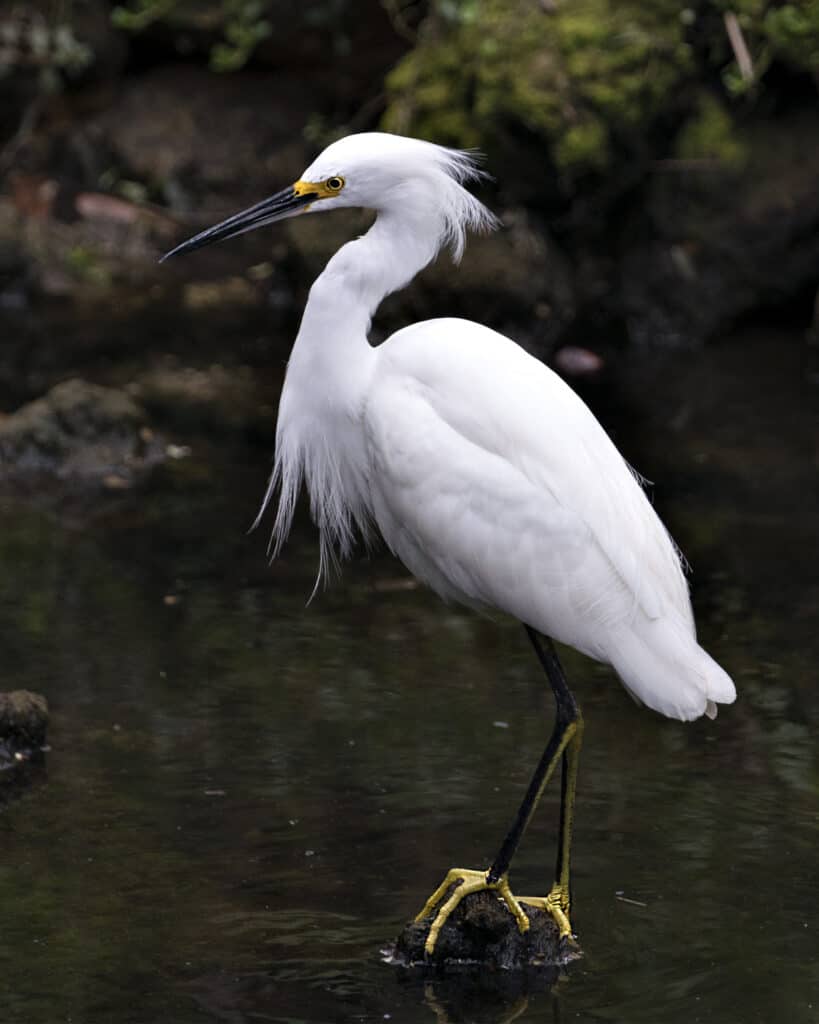Egret
Ardea alba, Bubulcus ibis, and others
Most species are relatively vocal, making harsh croaking sounds and squeals.
Advertisement
Egret Scientific Classification
- Kingdom
- Animalia
- Phylum
- Chordata
- Class
- Aves
- Order
- Pelecaniformes
- Family
- Ardeidae
- Genus
- Egretta, Ardea, Bubulcus, Mesophoyx
- Scientific Name
- Ardea alba, Bubulcus ibis, and others
Read our Complete Guide to Classification of Animals.
Egret Conservation Status
Egret Facts
- Prey
- Fish, crustaceans, amphibians, small mammals, reptiles, birds, and insects
- Main Prey
- Fish
- Name Of Young
- Nestlings, fledglings
- Group Behavior
- Semi-social
- Fun Fact
- Most species are relatively vocal, making harsh croaking sounds and squeals.
- Estimated Population Size
- Unknown
- Biggest Threat
- human exploitation, habitat loss, climate change, and pollution.
- Most Distinctive Feature
- Long legs and necks
- Distinctive Feature
- Slender bodies and long wings
- Wingspan
- 2 to 5 feet
- Incubation Period
- 22 to 28 days
- Age Of Independence
- 6 to 7 weeks
- Age Of Fledgling
- 3 to 4 weeks
- Habitat
- ponds, streams, lakes, marshes
- Predators
- Large birds, raccoons, and snakes
- Diet
- Carnivore
- Lifestyle
- Diurnal
- Favorite Food
- Fish
- Type
- Bird
- Common Name
- Egret
- Number Of Species
- 10
- Location
- Every continent
- Nesting Location
- high off the ground on the tops of shrubs and trees.
- Migratory
- 1
“The egret is a slow yet strong flier with powerful wingbeats.”
Summary
The egret (Ardeidae) is a long-legged, long-necked, wading bird inhabiting every continent. It lives in freshwater and saltwater habitats, such as marshes and wetlands, where it spends its day wading in shallow water, catching fish and other creatures. Most species form lifelong pair bonds with their mates and nest and roost in mixed species groups. Find out everything there is to know about this heron family, including where they live, what they eat, and how they behave.
5 Amazing Egret Facts
- Egrets avoid the coldest regions, high mountains, and deserts.
- They nest in tall trees over water with 10 to 30 other pairs.
- Most species are relatively vocal, making harsh croaking sounds and squeals.
- They feed in flocks, waiting in shallow water for fish to swim by before thrusting their beaks to catch their prey.
- Most animals don’t mess with these large birds; they find safety in numbers by staying in large communities.
Where to Find the Egret
Egrets live on every continent but avoid the coldest regions, arid deserts, and extremely high mountains. They live in areas with freshwater and saltwater, including ponds, streams, lakes, marshes, wetlands, shores, mud flats, and flooded meadows. Look for these birds feeding in flocks in shallow water, nesting in tall trees, or flying overhead with their long wings.
Egret Nest
Egrets nest in mixed colonies high off the ground on the tops of shrubs and trees. They typically find spots near water, usually in trees hanging over water. The nest itself is loosely formed and made with sticks and twigs.
Scientific Name
The egret (Ardeidae) is a family of herons from the Pelecaniformes order, encompassing webbed-foot waterbirds. Egret is French for “silver heron” and “brush,” referring to the cascading feathers down its back.
There are 12 recognized species of egret:
- Great egret or great white egret, Ardea alba
- Great blue heron, Ardea herodias
- Intermediate egret, Mesophoyx intermedia
- Cattle egret, Bubulcus ibis
- Little egret, Egretta garzetta
- Snowy egret, Egretta thula
- Reddish egret, Egretta rufescens
- Slaty egret, Egretta vinaceigula
- Black egret, Egretta ardesiaca
- Chinese egret, Egretta eulophotes
- Eastern reef egret or Pacific reef heron, Egretta sacra
- Western reef egret or Western reef heron, Egretta gularis
Size, Appearance, & Behavior

The snowy egret lives on the Gulf Coast year-round.
©iStock.com/Rejean Bedard
Egrets are long, slender, wading birds, measuring two to four feet long and weighing 7.8 ounces to 3.3 pounds, with a two to five-foot wingspan. These herons have long legs and necks; most have white or buff plumage with yellow, orange, or black bills. Egrets are somewhat social, forming long-term pair bonds and joining colonies (rookeries) during the breeding season. They are relatively vocal, making harsh, croaking noises and nasal squeals, especially when breeding. The egret is a slow yet strong flier with powerful wingbeats, reaching speeds up to 32 Mph.
Migration Pattern and Timing
Egrets are short to long-distance migrants. These birds fly in small flocks during the day and have varying migratory patterns. Some stay within a local area, while others travel many miles to reach warmer weather. Those in southern regions may not migrate at all.
Diet
Egrets are carnivores who mainly feed in flocks.
What Does the Egret Eat?
Their favorite food is fish, but they also eat crustaceans, amphibians, small mammals, reptiles, birds, and aquatic insects. They feed in flocks of the same species or in the company of other herons, ibises, and cormorants. They stand or slowly walk through shallow water, waiting for fish and other creatures to come near, then swiftly thrust their bill into the water.
Predators, Threats, and Conservation Status
The IUCN lists nine out of twelve egret species as LC or “least concern.” Due to their extensive range and large, stable, or increasing populations, the majority of these species do not meet the thresholds for “threatened” status. The reddish egret is listed NT or “near threatened,” and the Chinese and slaty egret are VU or “vulnerable.” At-risk species have many threats, including human exploitation, habitat loss, climate change, and pollution.
What Eats the Egret?
Adult egrets have very few, if any, predators. But their young are vulnerable to jays, vultures, crows, owls, hawks, raccoons, and snakes. Most creatures don’t mess with these large birds, but they also find safety in numbers. By roosting in large communities in tall trees, they can warm each other from intruders. Males and Females both aggressively defend their nests, as well.
Reproduction, Young, and Molting
Most egrets are seasonally monogamous, breeding with one mate per year. They can begin reproducing around two to three years old, and egg-laying starts in late February to mid-April. Females lay one to six eggs and incubate them for 22 to 28 days. Both parents feed the nestlings, and their young fledge the nest around three to four weeks after hatching, becoming independent at six to seven weeks. Their average lifespan is between five and ten years but can exceed more than 20.
Population
The global egret population is unknown. Out of 12 species, four have stable populations. Another four have increasing populations, and four have decreasing populations. Those with a downward trend include the intermediate egret, the reddish egret, the slaty egret, and the Chinese egret. The most common reason for decreasing numbers is climate change and human disturbance.
Related Animals:
View all 117 animals that start with EEgret FAQs (Frequently Asked Questions)
Where are egret found?
Egrets live on every continent but avoid the coldest regions, arid deserts, and extremely high mountains.
What kind of bird is an egret?
The egret (Ardeidae) is a family of herons from the Pelecaniformes order, encompassing webbed-foot waterbirds.
How big are egrets?
Egrets are long, slender, wading birds, measuring two to four feet long and weighing 7.8 ounces to 3.3 pounds, with a two to five-foot wingspan.
Are egrets loud birds?
They are relatively vocal, making harsh, croaking noises and nasal squeals, especially when breeding.
Do egrets migrate?
Egrets are short to long-distance migrants. These birds fly in small flocks during the day and have varying migratory patterns.
What do egrets eat?
Their favorite food is fish, but they also eat crustaceans, amphibians, small mammals, reptiles, birds, and aquatic insects.
What threatens egrets?
At-risk species have many threats, including human exploitation, habitat loss, climate change, and pollution.
Thank you for reading! Have some feedback for us? Contact the AZ Animals editorial team.
Sources
- Red List, Available here: https://www.iucnredlist.org/search?query=egret&searchType=species
- arcgis / Herons and Egrets Migration Paths and Patterns, Available here: https://www.arcgis.com/home/item.html?id=814ce4f9a57d4c639d3f63f21313e77f

















